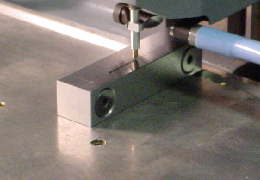Precision reference specimens have surfaces with profiles that are designed for checking and calibrating the metrological characteristics of a surface measuring instrument.
They are most often used with stylus-type contacting surface measuring instruments as standardised in ISO 3274, but are increasingly being used for checking optical and non-contacting instruments, especially with regard to roughness parameter evaluation.
At present, reference specimens for stylus instruments are standardised in ISO 5436-1, where they are referred to as material measures. In that document, specimens of type A are step-height standards, type B are for checking stylus size, types C and D are respectively regular- and random-profile specimens for checking instrument performance and parameter evaluation. The new standard ISO 25178-70 which belongs to the ISO 25178 family of standards for 3D areal surface measuring instruments, now covers all of the 2D specimens described in ISO 5436-1, and will soon replace the latter document.
All our precision reference specimens are made from electroformed nickel, available from us in 2 versions: with a hard protective top layer of nickel-boron (these are denoted by the letter E after the item no.), or without this top layer (with an X after the item no.) For example, item 542E is specimen 542 with a hard top layer. It sometimes happens that the protective layer shows slight discoloration or darkening, as compared with the bare nickel. This discoloration may take the form of faint dark patches or lines over the surface, but these are purely cosmetic and do not in any way alter the quoted roughness parameter values of the specimen.
A Note About UKAS Certification
Any of our specimens (*) can be calibrated by us in our UKAS-accredited Calibration Laboratory and be provided with a calibration certificate that states: the results of the calibration, the measuring conditions, and the measurement uncertainty. The price of such a calibration will depend on the exact requirements, therefore please enquire at time of ordering the specimen.
All of our specimens have the specimen’s principal parameter value engraved on the border or marked on a label. These values are based upon extensive measurements made upon the original master specimen from which replicas were made, and will therefore be sufficiently accurate for most practical purposes.
* In-house UKAS certification is at present unavailable for 3D areal specimens in the ranges 561 to 564, and 600 onwards. Certification for these may be available from other laboratories: please inquire when ordering.
Item 540: razor blade vise for checking stylus tip size
 The razor-
The razor-
This easy-





